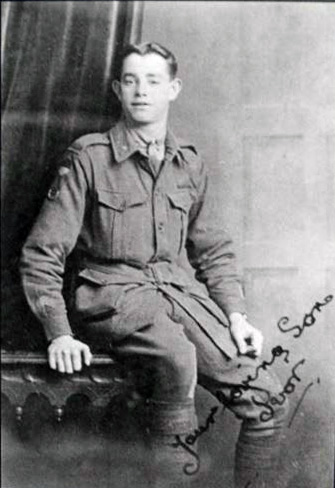Henry Ivor Passmore DCM
From Our Contribution
Revision as of 00:36, 15 August 2018 by Linton (talk | contribs) (Linton moved page Henry Ivor Passmore to Henry Ivor Passmore DCM without leaving a redirect)
 | |
| Personal Information | |
|---|---|
| Date of Birth | Not known |
| Place of Birth | North Fremantle, Western Australia |
| Age at Enlistment | 18 years |
| Description |
5'9" (1.75m) tall ; 130lbs 58.967 kg ; fresh complexion ; blue eyes ; fair hair |
| Occupation | Butcher |
| Religion | Church of England |
| Address | Gosnells, Western Australia |
| Next of Kin | Father , Mr Charles Christian Passmore |
| Military Information | |
| Reg Number | 7120 |
| Date of Enlistment | 16 Apr 1917 |
| Rank | Private |
| Unit/Formation | 28th Battalion, 21st reinforcement, transferred to the 51st Battalion |
| Date of Embarkation | 24 Jul 1917 ‒ 16 Sep 1917 |
| Ship Embarked On | HMAT A16 Port Melbourne Albany to Liverpool, England |
| Date of Return | 12 Jul 1919 |
| Ship Returned On | SS City of Exeter |
| Monument |
Gosnells Road Board Honour Roll Gosnells Primary School Honour Roll |
| Medals |
Distinguished Conduct Medal British War Medal Victory Medal |
Pre War
War Service
Entered camp on 16 Apr 1917 and was allocated to the 21st reinforcement draft for the 28th Battalion. Following basic training they embarked in Albany for England, disembarking in Liverpool.
On arrival he was sent to the 7th Training Battalion at Fovant on the Salisbury Plain in southern England. On 18 Sep 1917 he was admitted to the Parkhouse Military Hospital with mumps. Discharged from hospital on 9 Oct 1917 he was sent to the 6th Training Battalion, and from there, on 6 Mar 1918 Henry proceeded overseas to France as a reinforcement for the 51st Battalion.
At that time (13 March 1918) the battalion was at Locre (Loker) a small town in Flemish Belgium, only 1 kilometer from the boundary with France, north east of Bailleul. On the day he joined the 51st Battalion, it had been defeated by the 13th Australian Light Horse Regiment's AFL team 8.5 (53) to 6.13 (49).
On 5 Jun 1918 the 4th Division's Routine Orders at para 2069 noted that Ivor was to be awarded the Distinguished Conduct Medal for his actions in the evening of 24th/25th April 1918. The 51st Battalion with the 50th and 52nd moved around the town of Villers-Bretonneux to the south, joining up with units from the 15th Brigade that in a similar fashion had worked their way around the village to the north, and thus cutting of the Germans within the town from support and reinforcements. Other troops then cleared the village of enemy.
Ivor was wounded in action between 10 minutes before midnight on 9 Jun 1918 and 1:20am on 10 Jun 1918 when the enemy fired a barrage of gas shells into the 51st Battalion's positions near Sailly-le-sec. Seven men were overcome with the gas, Ivor being one of them. Treated first by the 5th Australian Field Ambulance who passed him on to the 61st Casualty Clearing Station the same day. Eventually he was settled in the 49th Casualty Clearing Station where he remained until 17 Jun 1918 when he was able to return to the battalion, joining them again on 19 Jun 1918. Ivor remained with the 51st Battalion, while enjoying leave to England between 1 Jan and 15 Jan 1919.
On 21 Feb 1919 Ivor was treated by the 13th Australian Field Ambulance for influenza, before passing him on to the 53rd Casualty Clearing Station the same day. Transferred to the 48th Casualty Clearing Station on 28 Feb 1919, and then the 53rd General Hospital at Boulogne on 5 Mar 1919. He rejoined his unit on 29 Mar 1919.
On 10 Jun 1919 Ivor was granted embarkation leave and was instructed to report to the No 4 Group at Hurdcott. Ivor was discharged by the5th Military District on 18 Sep 1919.
Award Comment
Distinguished Conduct Medal
"For conspicuous gallantry and devotion to duty. When his section commander had become a casualty, during a counter attack on strong enemy positions, this man who was a Lewis gunner, took command of the section and led them forward under heavy machine gun fire. He attacked an enemy strong point with the Lewis gun and with bombs, killing seven of the garrison and taking two prisoners. The remainder retired with disorderly celerity, leaving three machine guns in his hands. On continuing the advance with two men (all that remained of his section), finding he was far ahead of his company he returned, and, picking up on the way a man who was severely wounded, he carried him back into safety. During all this time Private Passmore was under heavy fire, and his great courage and rapid initiative were a fine example to every one." <ref>Recommendation Date 5 May 1918, published in the Commonwealth Gazette No 15 Dated 4 February 1919.Post War
Notes
External Links